France's Rafale fighter programme is midway through what could be a pivotal year in the Dassault type's potentially half-century service history. Already involved in NATO-led combat operations over Libya, the aircraft will return to frontline duty in Afghanistan inside the next two months. Its industrial backers are, meanwhile, edging seemingly closer to a long-awaited first export sale.
One of three fighters now in production in western Europe, along with the Eurofighter Typhoon and Saab Gripen, the Rafale has been in French military service since 2004, when it entered use with the nation's naval aviation wing.
Air force operations began two years later, and by late May the users had recorded more than 64,000 flight hours with a combined total of 94 aircraft. In September, Dassault and its programme partners, which include Sagem, Snecma and Thales, will celebrate the delivery of their 100th aircraft, including four development examples.
While the French navy's initial batch of 10 carrier-optimised Rafale Ms entered use with its 12F unit in an air-to-air-only standard dubbed F1, the fighter's capabilities have evolved greatly through two subsequent production standards. Each added new air-to-surface weapons and further capabilities, and as evidenced by the missions being flown in support of France's Harmattan commitment to NATO's Operation Unified Protector over Libya, the aircraft is now a truly potent asset.
 |
|---|
© DGA |
French air force Rafales have been involved in the coalition campaign to protect Libyan civilians from attack since "day one, hour one" |
Dassault describes its Rafale as being an "omnirole" fighter, a tag that it says denotes the type's ability to perform multiple mission types simultaneously. This differs from the widely adopted multi-role description used by its rivals largely as a result of the aircraft's ability to provide its pilot with data fused from onboard sensors, it says. These range from its Thales RBE2 fire-control radar, Spectra electronic warfare suite and passive front sector optronics equipment to the seekers on its MBDA Mica air-to-air missiles.
"The intention from the beginning was to develop a joint and omnirole Rafale," says Stéphane Reb, programme manager for France's DGA defence procurement agency.
"It was intended to perform air-to-air missions, deterrence, air-to-ground and reconnaissance," adds Reb.
This vision was realised in July 2008, with the introduction to service of the current F3 production-standard aircraft, the broad capabilities of which have been showcased during the Libyan campaign since hostilities commenced in mid-March.
Flight International visited the air force's Rafale detachment at Solenzara air base in Corsica in late May, just as NATO stepped up its campaign against forces loyal to Libyan leader Col Muammar Gaddafi.
With the Dassault Mirage 2000D strike aircraft and Mirage 2000-5 fighters that had operated from the Mediterranean island early in the campaign having relocated to Souda Bay, Crete, in late April, the flightline is now dominated by the service's newest addition, earning it the nickname Rafaletown.
GROUND SUPPORT
A detachment of seven Rafales - a mix of single-seat Cs and twin-seat Bs - is being operated from the site, accompanied by three Mirage F1 reconnaissance aircraft carrying Thales Presto wet-film camera pods. The commitment totals 15 aircrews from the 1/91 Gascogne and 1/7 Provence squadrons for the Rafale force, and five for the F1s. Around 100 ground support personnel are also involved, with roughly 70% of these associated with the newer type.
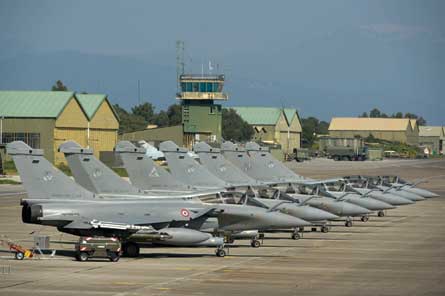 |
|---|
© DGA |
A seven-aircraft detachment is being sustained on the Mediterranean island of Corsica |
French strike aircraft were already in the air when the order was approved for the start of the then-US-led Odyssey Dawn operation on 19 March. "We were involved since day one, hour one," says the current chief of the Rafale detachment, who for operational security reasons can be named only as Lt Col Pierre.
Rafales dropped their first weapons against Libyan targets on 21 March, with these early strikes having been launched from Saint-Dizier air base on the French mainland. Two days later, a major raid also involving navy Rafale Ms flying from the aircraft carrier Charles de Gaulle attacked a Libyan air force base 250km (135nm) inland, and saw France's debut combat use of MBDA's Scalp-EG cruise missile. Identical to the Storm Shadow weapons employed by UK's Royal Air Force Panavia Tornado GR4 strike aircraft earlier in the conflict, they were used to take out infrastructure targets during the French mission.
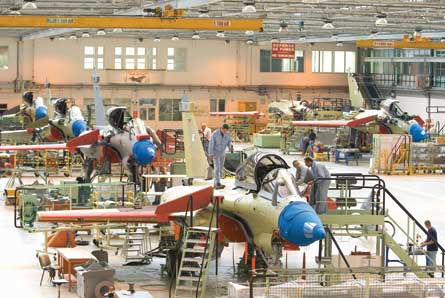 |
|---|
© Dassault |
Dassault delivers 11 fighters a year off its Merignac assembly line, but could more than double this rate to meet export demand |
Through its transition to NATO control on 31 March and beyond, the Libyan operation has maintained a high operational tempo. By late May the Rafale detachment at Solenzara had logged around 2,200 flight hours, with "zero no-fly days" reported since the type's arrival. Typically, its crews fly between a combined four and eight sorties a day, each with a transit time of around 2h before they reach the North African coast.
"They can be 6-8h flights, depending on the mission," says Pierre. Due to this extended endurance, the aircraft rely on the provision of tanker support from French air force Boeing C-135s and other coalition assets, such as US Air Force KC-135s. Three or four in-flight refuellings are required on each mission, and more than 1,500 have been performed so far.
Although air force officials say the long-range missions cause no problems with regard to airframe wear and tear, and pilots hail the fighter's cockpit ergonomics for minimising crew fatigue, the service has requested a move away from Corsica. If approved, this should see the detachment relocate to Sigonella in Sicily, and reduce combined transit times by between 90min and 2h per sortie.
The Rafale's main weapons in Libya are Sagem's AASM precision-guided bomb, in its GPS/INS-guided GBU-38 guise, and Raytheon's GBU-12 Paveway II, which have release weights of 226-250kg (500-550lb). By late last month more than 100 had been dropped, with the latter, laser-guided type now being used more frequently due to the clear weather conditions experienced in the operating area.
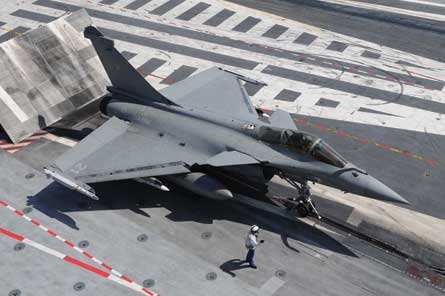 |
|---|
© DGA |
The French navy will get 58 Rafale Ms in total |
Libya represents the first opportunity for the French air force to employ the Thales Damocles targeting pod, although the navy gave the system its combat debut over Afghanistan in late 2010.
Also referred to as the Hammer, the AASM weapon has impressed during the campaign to date. Incorporating a precision guidance kit and propulsion system, the design will eventually be available for use with standard bombs weighing between 125kg and 1,000kg, although a 250kg version is the only one currently in service. Sagem cites a range capability of more than 32nm from high altitude, or 8nm from low level.
Launches can also be made from an off-axis angle of up to 90°, while up to six weapons can be fired against individual targets in a single pass and with just one trigger press.
ILLEGAL MOVEMENT
An AASM was employed in late March when an air force Rafale destroyed a Soko G-2 Galeb that had violated the UN-mandated no-fly zone over Libya. A French Boeing E-3F airborne warning and control system aircraft had detected the illegal movement near Misrata, but the trainer had landed before permission came to shoot it down, sources say. With the Sagem weapon lacking the ability to strike moving targets - a function that will become operational with a laser-guidance update in 2013 - the aircraft is believed to have been stationary when it was hit.
The Rafale's ability to adapt to the changing nature of the Galeb strike reflects the flexibility needed to react to events in Libya. While a master air campaign plan is issued 48h in advance of a sortie and a more detailed air tasking order arrives 24h before the aircraft fly, Pierre says his aircraft are routinely re-tasked once airborne. "Air-to-surface, air-to-air, all weather, day and night. Over Libya we are flying those kinds of omnirole missions," he says. "It is very easy and practical to task us - it reduces the complexity of missions and reduces the tasking plan." According to the French air force, a two-ship formation of Rafales can provide NATO with the same payload and situational awareness as a flight of four Mirage 2000Ds and two Mirage 2000-5s.
Solenzara-based aircraft also typically fly daily missions over Libya carrying Thales's Reco-NG/Areos digital reconnaissance pod, which can obtain pre- and post-strike imagery, and also record video footage of attacks.
Pierre says pilots can transmit pictures to the imagery intelligence cell at their operating base while still in the air, or alternatively to Rafale Ms aboard the Charles de Gaulle if potential targets are found. This can save precious hours against the previous-generation Mirage F1 and Presto combination.
"The Rafale really is a gathering platform. You're being fed by different means - that can be via AWACS using Link 16, or from your wingman, all with no radio communications," Pierre says. "All the information you can get from your sensors is vital."
Urgent operational requirements have emerged from Libya, and also from Afghanistan before it. The air force is now seeking a weapon with a reduced collateral effect to give it a lighter-weight option than its 250kg AASM. Candidates include MBDA's dual-mode Brimstone missile, now used by RAF Tornado GR4s, and guided rockets.
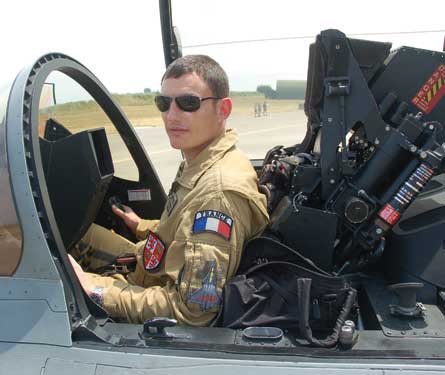 |
|---|
© Craig Hoyle/Flightglobal |
Pilots say the Rafale is "a pleasure to fly" |
It is also urgently looking to field versions of the Hammer that have been optimised for use against armoured targets and in a close air support scenario. Development work on the latter has already been performed, with the new mode to enable the bomb to descend on its target in a corkscrew motion from above, rather than be fired from stand-off range.
These and other enhancements will boost the ability of pilots to perform their duty in Libya, and also in Afghanistan, where they will return to duty on 1 August. Noting that the type made its offensive debut in 2007, Reb says: "When we say that the Rafale is a combat-proven aircraft, it's not only words."
Getting it right when it comes to introducing new weapons and sensors is of critical importance to France, as by 2015 it will have streamlined its combat aircraft fleets to operating the type alongside only the Mirage 2000-5 and 2000N strike aircraft.
By 2030 the Rafale will be its sole manned fighter, although the air force could also start to field an unmanned combat air system from around this time.
Signed in December 2009 and covering the delivery of 60 aircraft, the programme's fourth order will extend production up to the end of 2019. Paris's commitment takes to 180 the number of Rafales to be produced for its air force and navy, from a total commitment for 286 aircraft: 228 B/Cs and 58 Ms, respectively. "With the other aircraft that we still have to order, we plan to keep the production line running until 2025," says Reb.
The current rate is set to deliver 11 aircraft a year, with around six on the line at any one time at Dassault's Merignac site. The goal is for each aircraft to spend around five months between the arrival of its main structures and customer acceptance, with roughly 70% of the activity at the site concerned with test activities, such as on fuel and hydraulics systems and flight controls.
Growing combat experience will only strengthen Dassault's efforts to sell the Rafale to international customers, and it now has several strong prospects. The company is waiting on the outcome of the roughly 36-aircraft F-X2 competition in Brazil, where its product had the open support of former president Luiz Inacio Lula da Silva in a battle against the Boeing F/A-18E/F Super Hornet and the Gripen NG. A decision is expected to be made in 2012.
The Rafale has also reached the final two candidates in India's medium multi-role combat aircraft contest, with the Typhoon also in contention to supply the nation's air force with at least 126 fighters.
SPECULATION
Fresh speculation has also emerged over the past few weeks with regard to a long-expected deal with the United Arab Emirates, where the French air force already bases some of its aircraft. Dassault says it would have no problem with increasing its current build rate, having previously run the Merignac line at a rate of two aircraft a month. "We've done a study to up to treble the current rate, and could do it," says Jean-Marc Gasparini, the company's vice-president military aircraft. "It's a problem we would like to have."
Five of the Rafales to be delivered this year have already been handed over, and among those currently on the line is the 100th to have been built: a C-model fighter for the air force.
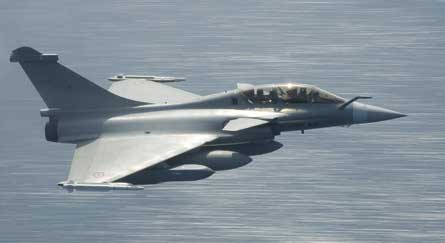 |
|---|
© Alexandre Paringaux/MBDA |
Operation Harmattan included France's first use of MBDA's Scalp-EG cruise missile |
Another milestone should be reached in June, when a second navy squadron - 11F - will begin operations. MBDA is also within weeks of delivering its first AM39 Exocet Block 2 Mod 2 anti-ship missiles to arm the service's Rafale Ms. Its first, F1-standard fighters remain in storage, but will be modified to the F3 configuration before entering use again between 2014 and 2017.
All early-production aircraft will eventually be brought up to the latest standard, while further upgrades are planned over the coming years. "The main aim is to keep the Rafale at the top level of performance and capability," says Reb. The next standard to enter frontline use, in mid-2013, is dubbed F3-04T. This will introduce an active electronically scanned array with the RBE2 radar, the laser-guided AASM, improved front sector optronics and MBDA's DDM-NG passive missile approach warning system.
Down the line, the European company's Meteor beyond visual-range air-to-air missile should enter French use around 2018, although Reb says this could occur "faster, if necessary". The DGA late last year ordered its first 200 of the weapon, which is also being developed for Germany, Italy, Spain, Sweden and the UK.
Funded research and development studies are already looking towards possible enhancements to be made several years beyond this point. Reb identifies areas such as a reduction to the aircraft's radar cross-section, expanded flight envelope, human/machine interface enhancements and new communications equipment and weapons. A mid-life update is also planned from around 2025, but the requirements for this have yet to be defined.
For now, the French air force and navy are meeting requirements with their modest fleets of the new-generation type, which are expanding slowly due to budgetary constraints. However, this ability could soon be tested as never before, as a protracted Libyan campaign would be in addition to the operational demands of Afghanistan. If the Unified Protector/Harmattan mission is to run on, the air force's commitment will continue to be maintained by drawing pilots and personnel from squadrons on a rotation basis. "It's long-term planned; we can sustain the operation," says Pierre.
"In Libya we use the Rafale to 100% of its capability as an omnirole aircraft. In a single mission you do reconnaissance, air-to-air and air-to-ground. It's a real pleasure to fly this aeroplane," he adds.
To find out about the Rafale's performance, read Peter Collins' flight test report:
INDUSTRY PARTNERS TEST NEXT PACKAGE OF ENHANCEMENTS
FRANCE'S most recent production order for the Dassault Rafale will lead to the delivery from mid-2013 of 60 aircraft with an enhanced range of "omnirole" capabilities. Spanning the sensor, propulsion and weapons spheres, the developments are the focus of advanced activities involving partner companies Thales, Snecma and Sagem, plus the French military's CEV flight test organisation.
One of the most important advances will be the introduction of an active electronically scanned array for the RBE2 radar. Now a key equipment requirement in most fighter sales campaigns around the globe, the technology promises increased detection range, improved reliability and reduced maintenance demands through-life.
Thales is now working on its first series production examples of the AESA sensor, while a performance evaluation test campaign is under way at the CEV's Cazaux site. A modified Mirage 2000 is currently being flown with a Rafale nose section that accommodates a test version of the active array, with an adapted Falcon 20 business jet also being used to support the effort.
The AESA integration was validated on a Rafale in February, and Thales says flight tests so far have demonstrated that "all aspects of the radar's performance comply with the technical specifications of the contract".
Any future export sale of the Rafale to nations such as Brazil or India would contain the new sensor configuration.
Propulsion system supplier Snecma, meanwhile, will deliver its first enhanced examples of the M88 engine to Dassault's Merignac final assembly site in November, after completing the last test activities on the -4E version this month.
Drawing on the activities of Snecma's ECO development programme of 2004-07, the new standard will reduce ownership costs and maintenance demands, and will also have the growth potential to increase available power from a current maximum of 17,000lb (75kN) to roughly 19,800lb.
Key changes include a new high-pressure turbine, three new HP compressor stages and some changes to materials and geometry. More than 70 test flights have been performed, and "all the test objectives have been met", says M88 project leader Bruce Pontoizeau. "If anyone wants a 9t [rated] engine it can be there in the programme," he adds.
 |
|---|
© Thales, DGA, Sagem |
Flight-test activities have already proven the AESA-equipped RBE2 radar, enhanced M88 engine and laser-guided AASM Hammer |
Such an enhancement would be of particular interest to the United Arab Emirates, which has long been interested in acquiring the Rafale, but has requested that it be made available with an increased power output.
Sagem had by late May delivered 260 M88 engines, with a further 146 on firm order.
Another capability that is to come with the next batch of aircraft will be a laser-guided version of Sagem's AASM Hammer precision-guided bomb.
Used extensively during France's current involvement in Libya, the weapon is now available with GPS/INS guidance.
This will also be combined with an infrared seeker in use from 2012. But while the AASM boasts all-weather capability and a stand-off range of more than 32nm (60km), it lacks the ability to strike moving targets.
A new laser-guided version was demonstrated in three test firings last year. These included a strike against a target from a vertical trajectory, another which replicated the future availability of an advanced targeting pod, and a shot in which the weapon tracked a laser spot from a turret-mounted ground illuminator travelling at 43kt (80km/h) and replicating a moving vehicle. It hit the target less than 1m (3ft) away from the spot.
Three qualification tests will be conducted next year against "representative targets".
Source: Flight International



















